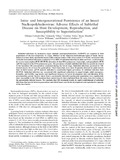Mostrar el registro sencillo del ítem
Intra- and intergenerational persistence of an insect nucleopolyhedrovirus: adverse effects of sublethal disease on host development, reproduction, and susceptibility to superinfection
| dc.creator | Cabodevilla de Andrés, Oihana | es_ES |
| dc.creator | Villar Zabal, Eduardo | es_ES |
| dc.creator | Virto Garayoa, Cristina | es_ES |
| dc.creator | Murillo Pérez, Rosa | es_ES |
| dc.creator | Williams, Trevor | es_ES |
| dc.creator | Caballero Murillo, Primitivo | es_ES |
| dc.date.accessioned | 2019-01-10T08:27:56Z | |
| dc.date.available | 2019-01-10T08:27:56Z | |
| dc.date.issued | 2011 | |
| dc.identifier.issn | 0099-2240 (Print) | |
| dc.identifier.issn | 1098-5336 (Electronic) | |
| dc.identifier.uri | https://hdl.handle.net/2454/31943 | |
| dc.description.abstract | Sublethal infections by Spodoptera exigua multiple nucleopolyhedrovirus (SeMNPV) are common in field populations of the beet armyworm (S. exigua, Hübner) in the Almerian horticultural region of Spain. Inoculation of second, third, and fourth instars with occlusion bodies (OBs) of an isolate (VT-SeAl1) associated with vertically transmitted infections resulted in 15 to 100% of sublethal infection in adult survivors, as determined by reverse transcription-PCR (RT-PCR) detection of viral DNA polymerase transcripts, and quantitative PCR (qPCR) targeted at the DNA polymerase gene. The prevalence of adult sublethal infection was positively related to the inoculum OB concentration consumed during the larval stage. Sublethal infections persisted in OBtreated insects for at least five generations. Viral transcripts were more frequently detected in adult insects than in third instars. qPCR analysis indicated a consistently higher prevalence of sublethal infection than RT-PCR. Sublethal infection was associated with significant reductions in pupal weight, adult emergence, fecundity, and fertility (egg hatch) and significant increases in larval development time and duration of the preoviposition period. Insects taken from a persistently infected experimental population were significantly more susceptible to the OB inoculum than control insects that originated from the same virus-free colony as the persistently infected insects. We conclude that OB treatment results in rapid establishment of sublethal infections that persist between generations and which incur costs in the development and reproductive capacity of the host insect. | en |
| dc.description.sponsorship | This study received financial support from the Spanish Ministry for Science and Technology (AGL2005-07909-CO3-01 and AGL2008- 05456-C03-01). O.C. received a predoctoral fellowship from the Spanish Ministry of Education and Science. | en |
| dc.format.extent | 7 p. | |
| dc.format.mimetype | application/pdf | en |
| dc.language.iso | eng | en |
| dc.publisher | American Society for Microbiology | en |
| dc.relation.ispartof | Applied and Environmental Microbiology, May 2011, p. 2954–2960 | en |
| dc.rights | © 2011, American Society for Microbiology. All Rights Reserved. | en |
| dc.subject | Spodoptera exigua multiple nucleopolyhedrovirus (SeMNPV) | en |
| dc.subject | Occlusion bodies (OBs) | en |
| dc.title | Intra- and intergenerational persistence of an insect nucleopolyhedrovirus: adverse effects of sublethal disease on host development, reproduction, and susceptibility to superinfection | en |
| dc.type | info:eu-repo/semantics/article | en |
| dc.type | Artículo / Artikulua | es |
| dc.contributor.department | Producción Agraria | es_ES |
| dc.contributor.department | Nekazaritza Ekoizpena | eu |
| dc.contributor.department | IdAB. Instituto de Agrobiotecnología / Agrobioteknologiako Institutua | es |
| dc.rights.accessRights | info:eu-repo/semantics/openAccess | en |
| dc.rights.accessRights | Acceso abierto / Sarbide irekia | es |
| dc.identifier.doi | 10.1128/aem.02762-10 | |
| dc.relation.publisherversion | https://doi.org/10.1128/aem.02762-10 | |
| dc.type.version | info:eu-repo/semantics/publishedVersion | en |
| dc.type.version | Versión publicada / Argitaratu den bertsioa | es |


